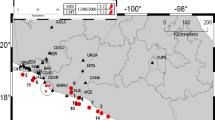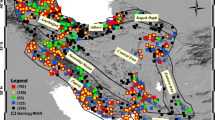Abstract
Rotation motion and its effects on strong-motion data, in most cases, are much smaller than that of translational motion and have been ignored in most analyses of strong-motion data. However, recent observations from near-fault and/or extreme large ground motions suggest that these effects might be underestimated and quantitative analyses seem to be necessary for improving our understating of these effects. Rotation motion-related effects include centrifugal acceleration, the effects of gravity and effects of the rotation frame. Detailed analyses of these effects based on the observed data are unavailable in the literature. In this study, we develop a numerical algorithm for estimating the effects of rotational motion on the strong-motion data using a set of six-component ground motions and apply it to a set of rotation rate-strong motion velocity data. The data were recorded during a magnitude 6.9 earthquake. The peak value of the derived acceleration and rotation rate of this dataset are about 186 cm/s/s and 0.0026 rad/s. Numerical analyses of data gives time histories of these rotational motion-related effects. Our results show that all the rotation angles are less than 0.01°. The maximum centrifugal acceleration, effect from gravity and effect of the rotation frame are about 0.03 and 0.14 cm/s/s, respectively. Both these two effects are much smaller than the peak acceleration 186 cm/s/s. This result might have been expected because our data are not near-field and wave motions are expected to be nearly plane waves. However, it is worth noticing that the centrifugal acceleration is underestimated and a small rotational effect can cause large waveform difference in acceleration data. The waveform difference before and after the correction for rotational motion can reach 16 cm/s/s (about 10 %).









Similar content being viewed by others
References
Boore DM (2001) Effect of baseline corrections on displacements and response spectra for several recordings of the 1999 Chi-Chi, Taiwan, earthquake. Bull Seismol Soc Am 91(5):1199–1211
Boroschek RL, Legrand D (2006) Tilt motion effects on the double-time integration of linear accelerometers: an experimental approach. Bull Seismol Soc Am 96(6):2072–2089
Chiu HC (1997) Stable baseline correction of digital strong-motion data. Bull Seismol Soc Am 87(4):932–944
Clinton JF, Heaton TH (2003) Performance of the VSE-355G2 strong-motion velocity seismometer. Report to the IRIS-GSN subcommittee, Version II, California Institute of Technology, Pasadena, p 60
Graizer V (2005) Effect of tilt on strong motion data processing. Soil Dyn Earthq Eng 25(3):197–204
Graizer V (2009) Tutorial on measuring rotations using multipendulum systems. Bull Seismol Soc Am 99(2B):1064–1072
Graizer V, Kalkan E (2008) Response of pendulums to complex input ground motion. Soil Dyn Earthq Engin 28(8):621–631
Hutt CR, Evans JR, Yokoi I (2008) A brief test of the Tokyo Sokushin VSE–355G3 strong motion velocity seismometer. U.S. Geological Survey Open-File report 2008–1311, p 43
Lee WHK, Huang BS, Langston CA, Lin CJ, Liu CC, Shin TC, Teng TL, Wu CF (2009) Review: progress in rotation ground-motion observations from explosions and local earthquakes in Taiwan. Bull Seismol Soc Am 99(2B):958–967
Lin CJ, Huang HP, Liu CC, Chiu HC (2010) Application of rotation sensors to correcting rotation-induced effects on accelerometers. Bull Seismol Soc Am 100(2):585–597
Nigbor RL, Evans JR, Hutt CR (2009) Laboratory and field testing of commercial rotational seismometers. Bull Seismol Soc Am 99(2B):1215–1227
Pillet R, Virieux J (2007) The effects of seismic rotations on inertial sensors. Geophys J Int 171(3):1314–1323
Takeo M (2009) Rotation motions observed during an earthquake swarm in April 1998 offshore Ito, Japan. Bull Seismol Soc Am 99(2B):1457–1467
Acknowledgments
We are grateful to Dr. Zembaty and two anonymous reviewers for their valuable suggestions. This research was supported by Academia Sinica and the National Science Council, Taiwan, Republic of China. The HWA019 strong-motion data was provided by Central Weather Bureau, Taiwan. The support from these organizations is gratefully acknowledged.
Author information
Authors and Affiliations
Corresponding author
Rights and permissions
About this article
Cite this article
Chiu, H.C., Wu, F.J., Lin, C.J. et al. Effects of rotation motions on strong-motion data. J Seismol 16, 829–838 (2012). https://doi.org/10.1007/s10950-012-9301-z
Received:
Accepted:
Published:
Issue Date:
DOI: https://doi.org/10.1007/s10950-012-9301-z




